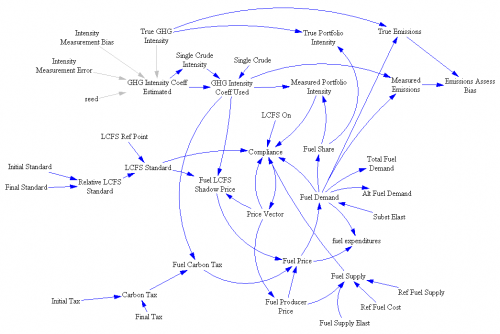Model Name: A Behavioral Analysis of Learning Curve Strategy
Citation: A Behavioral Analysis of Learning Curve Strategy, John D. Sterman and Rebecca Henderson, Sloan School of Management, MIT and Eric D. Beinhocker and Lee I. Newman, McKinsey and Company.
Neoclassical models of strategic behavior have yielded many insights into competitive behavior, despite the fact that they often rely on a number of assumptions-including instantaneous market clearing and perfect foresight-that have been called into question by a broad range of research. Researchers generally argue that these assumptions are “good enough” to predict an industry’s probable equilibria, and that disequilibrium adjustments and bounded rationality have limited competitive implications. Here we focus on the case of strategy in the presence of increasing returns to highlight how relaxing these two assumptions can lead to outcomes quite different from those predicted by standard neoclassical models. Prior research suggests that in the presence of increasing returns, tight appropriability and accommodating rivals, in some circumstances early entrants can achieve sustained competitive advantage by pursuing Get Big Fast (GBF) strategies: rapidly expanding capacity and cutting prices to gain market share advantage and exploit positive feedbacks faster than their rivals. Using a simulation of the duopoly case we show that when the industry moves slowly compared to capacity adjustment delays, boundedly rational firms find their way to the equilibria predicted by conventional models. However, when market dynamics are rapid relative to capacity adjustment, forecasting errors lead to excess capacity, overwhelming the advantage conferred by increasing returns. Our results highlight the risks of ignoring the role of disequilibrium dynamics and bounded rationality in shaping competitive outcomes, and demonstrate how both can be incorporated into strategic analysis to form a dynamic, behavioral game theory amenable to rigorous analysis.
The original paper is on Archive.org ; it was eventually published in Management Science. You can get the MS version from John Sterman’s page here.
Source: Replicated by Tom Fiddaman
Units balance: Yes
Format: Vensim (the model uses subscripts, so it requires Pro, DSS, or Model Reader)
Behavioral Analysis of Learning Curve Strategy (Vensim .vmf)
New update:
BALCS4b.zip

